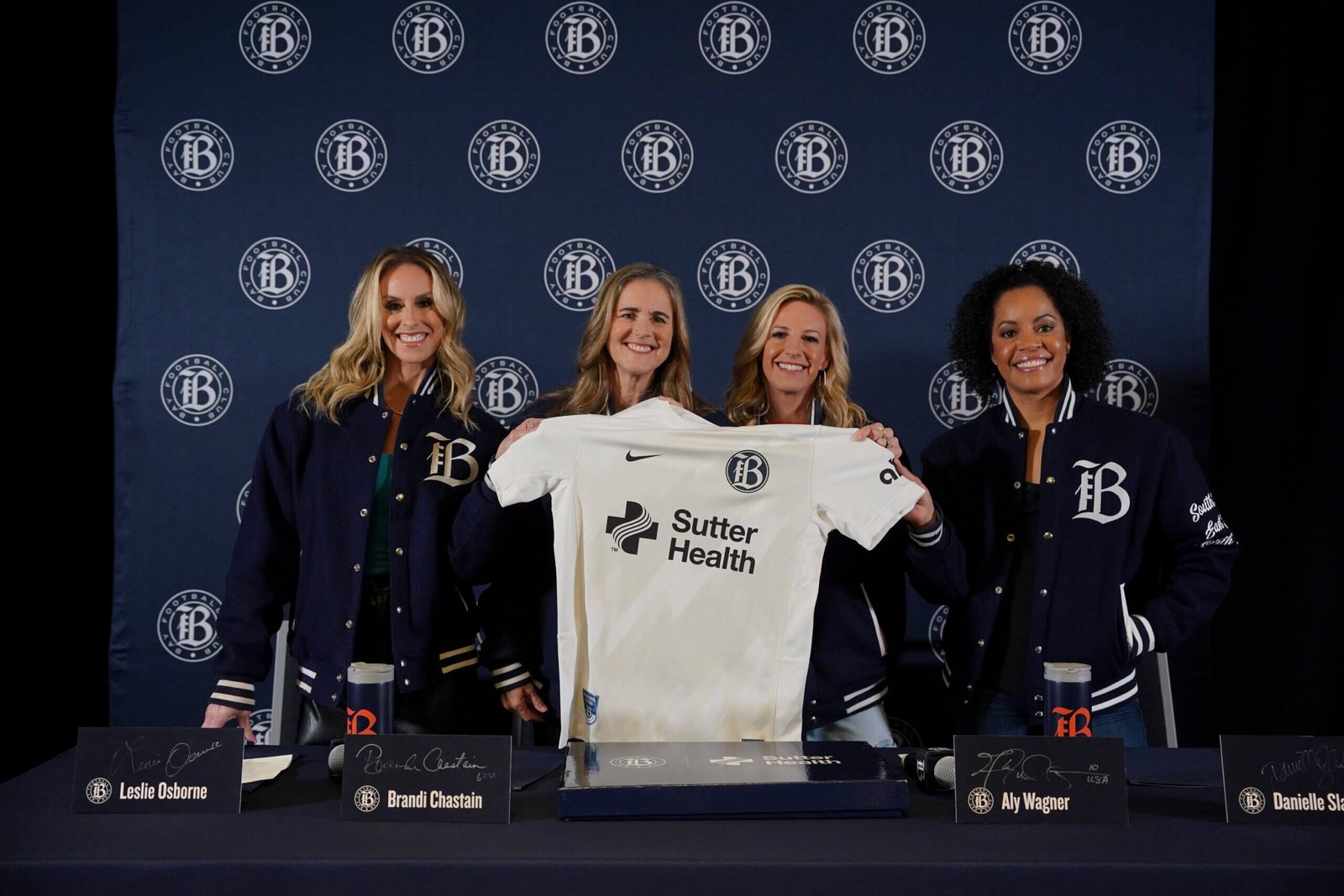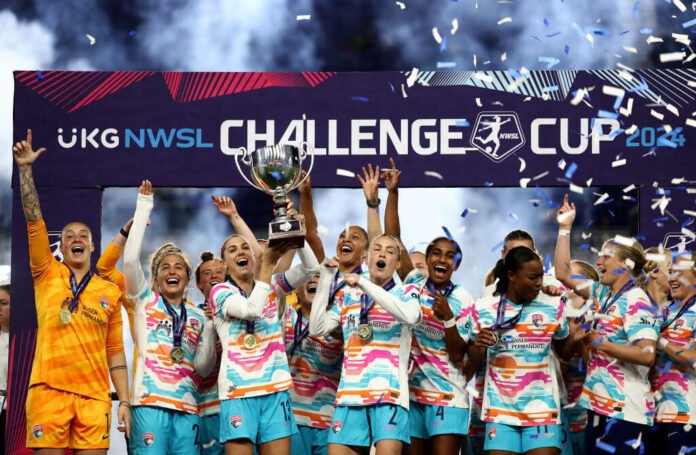Over a span of five days this month, two NWSL clubs were sold and a third began searching for additional investors, setting the tone for what is shaping up to be a record year for professional women’s soccer in the United States.
It started with San Diego Wave FC when the team’s principal owner Ron Burkle agreed to sell the club at a total valuation of $120 million with an initial cash outlay of $113 million, nearly doubling the league’s previous record sale of $63 million for the Portland Thorns in January. Burkle originally paid $2 million in expansion fees to bring professional women’s soccer to California’s southernmost county in 2021.
The following day, news broke that Angel City FC, considered the most profitable club in the NWSL by Sportico’s valuations, was shopping around for a new investor. On Tuesday, a source briefed on the talks confirmed to The Athletic the franchise had hired Moelis & Company, an investment bank, to seek out further investment for fundraising. That process could result in a new controlling owner, helping the franchise move closer to its ambitions of reaching a billion-dollar valuation in the coming years. Further investment in the club could potentially yield another record transaction, like in San Diego. Angel City’s plans were first reported by Sportico.
Actress Natalie Portman, Julie Uhrman and Kara Nortman are the co-founders of Angel City (Photo by Allison Zaucha, Getty Images)
Later in the week, Seattle Reign and its owner, OL Groupe, announced the team was finalizing a $58 million sale to a group headlined by Major League Soccer’s Seattle Sounders. It marked a significant return for OL Groupe, which bought the Reign for $3.51 million in 2020.
The NWSL is on an upward trajectory as it enters its 12th year, with more investors ready to buy in. The rapidly rising valuations of clubs are a key marker of the league’s growth, experts say, and, with each record transaction, a new benchmark is set.
Rising valuations, in particular, are key indicators that experts typically use to check a league’s temperature. “In the sports world, franchise valuation is one of the big metrics for where and how you measure the growth of the league,” said Pete Giorgio, who leads Deloitte’s global and U.S. sports practice.
The league’s growth is in lockstep with the growth of women’s sports over the last several years, Giorgio said. There’s been growth in franchise valuations, media rights deals, ticket prices and sponsorships deals, with the NWSL very much in the mix.
“All of the measures of women’s sports right now are growing, and I think the NWSL is at the forefront of a lot of that,” Giorgio said. “Those large valuations and these large transactions validate both the foresight, but also the investment that a lot of people made in the first place.”
The cost of entering the NWSL has shot up significantly in recent years. Ownership groups in Boston and the San Francisco Bay Area paid roughly $50 million each in franchise fees to enter the league, the most of any previous payments required to do so.
Team valuations are also at record highs, with Sportico in October determining a range of $40 million (Chicago Red Stars) to $180 million (Angel City FC). That data valued San Diego as having the second-highest valuation at $90 million.

Bay FC joined NWSL in 2024 as an expansion team. (Photo by Bay FC via USA TODAY Sports)
It’s important to note that valuations and sale prices don’t always align, according to Andrea Sartori, chief executive and founder of Hungary-based Football Benchmark, a digital analytics platform that focuses on the business of soccer.
“It’s crucial to distinguish between price and value as two distinct concepts, often diverging from each other. Nevertheless, when a transaction such as the one witnessed in San Diego occurs, it establishes market pricing and serves as a benchmark for other franchises,” he said. “Furthermore, it underscores the substantial growth opportunities within international women’s football, especially within the United States.”
Those opportunities have grown significantly in the last five years, Satori says, citing the growing interest of media, fans and rights holders. Though disparity between the women’s and men’s sides persists, particularly when comparing revenues and transfer fees, that gap is smaller in countries like the U.S., Australia and Sweden, he said.
“In terms of the value of current annual broadcasting deals, the USA leads the field by a significant margin with its annual contract valued at 55.4 million euros,” Sartori added. “By comparison, the second-ranked English broadcasting deal has an annual fee of eight million euros.”
That NWSL broadcast deal, announced in November between four media partners, totals $60 million a year combined, across a four-year deal with ESPN, CBS Sports, Amazon Prime Video and Scripps Sports.
Sponsorships in the league are up 98%, said Julie Haddon, the league’s chief marketing and commercial officer, at the SportsPro Media conference in New York last week.
“We’ve been adding, we’ve been building our campaigns, we’ve been building our player stories, we’ve been building our attendance stories, (there are) records that are being broken, our sponsorships (are) up 98%,” she said. “Recently we announced Amazon, and a month ago we announced Google… joining already existing partners like Ally and Adobe and many others.”
Haddon, a former owner of the Chicago Red Stars, previously worked at tech startups and compared the NWSL’s growth to what she witnessed in Silicon Valley. “I remember being at Twitter when there were a dozen or so people there, or at SoFi early and thinking, ‘This is our hockey stick moment.’ What (the NWSL) have now (is we’ve) been really starting to become recognized as the global powerhouse that we are.”
That recognition came after a period of upheaval in the league, following the release of the Sally Yates Report in 2022, which outlined years of past abusive behavior and sexual misconduct in professional women’s soccer.
Four NWSL teams have changed owners in the last six months, starting with the Chicago Red Stars, which were purchased by a Laura Ricketts-led group for $60 million in September 2023. By January, the $63 million sale of the Portland Thorns to RAJ Sports was also finalized. These sales were a symbolic turning of the page for the two franchises, as they were the main clubs highlighted by investigative reporting and multiple official investigations that exposed years of systemic abuse in the league.

Laura Ricketts led a group of investors that bought the Red Stars in 2023. (Photo by Daniel Bartel, USA TODAY Sports)
Earlier in 2022, Michele Kang successfully acquired the controlling interest of the Washington Spirit after previously serving as the club’s co-owner. Kang became the first woman of color to own a controlling stake in an NWSL team, successfully taking power after a contentious months of fighting with ex-owner Steve Baldwin. Players and fans had demanded Baldwin sell the team to Kang in the wake of abuse allegations against the Spirit’s former coach, Richie Burke.
Now, as leadership front offices have shifted, the league is stabilizing again.
The league recently navigated a transfer window that brought top international talent to the NWSL, helping set the foundation for a burgeoning global market. Ahead of this year’s Challenge Cup at Red Bull Arena, and on the eve of the 2024 season, NWSL commissioner Jessica Berman described transfer fees as “an additional mechanism that investors will analyze as a way to get a return on their investment.”
“You can think of players as assets. You’re investing in these humans because that is the product that we put out on the pitch, and as there becomes a buyer and seller market for transfer players, which exists on the men’s side — it is the reason that there has been so much investment in academies and other ways of developing talent on the men’s side that we’re starting to see on the women’s side — that’ll only fuel incremental investment,” she said.
In November, Deloitte predicted that women’s sports will generate global revenues of $1.28 billion in 2024, marking the first time global revenues for the sector exceed the billion-dollar threshold. That estimate is 300% higher than their 2020 valuation. Part of that growth is fueled by the growing interest from would-be investors, like the Levine Leichtman family who are buying San Diego Wave.
“Now that we’re starting to get to the numbers that we’re getting to, you’re seeing a lot more structured, well-organized investors coming into the league,” said Giorgio. “So, you’re seeing, basically, (these deals) raising the level of execution, not just on the pitch, but also in the boardroom, in terms of where and how these organizations operate.
“It’s very different when you’re spending over $100 million to buy a team. You have a very different mindset than if you’re only spending $5 million to buy a team, just in terms of how you want to operate that team, the types of people you want to bring in.”
That, in turn, elevates the league, fueling future growth. “Original investors are getting rewarded,” Giorgio explained. “You’re bringing in people who are serious about this, and you’re seeing a lot more investment going into these things and a lot more structure and operational and business prowess coming out of that, too.”
This trajectory is why an unprecedented level of investment is being made in women’s sports, and why more record deals are likely on the horizon in the NWSL, especially with Angel City now involved in the potential market. The increase in investment is also simply because, as Sartori pointed out, there is significant potential for those who choose to invest.
“In the realm of football, acquiring a women’s club may currently prove to be a more financially lucrative investment than acquiring a men’s football club,” Sartori said. “When undertaken by an investor well-versed in football club management, purchasing a women’s football club could yield considerable success as a business venture.”
(Top photo: Elsa/Getty Images)
Read the full article here


